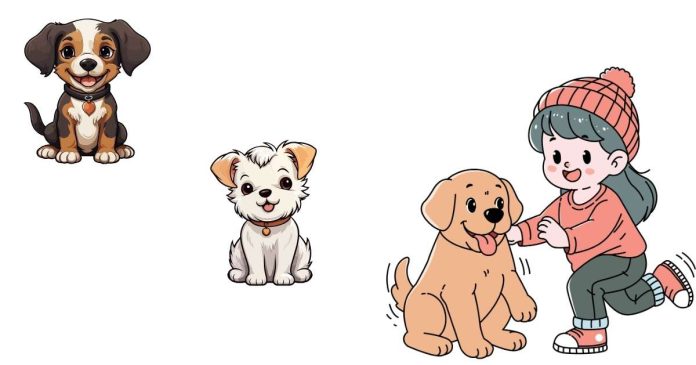Bringing home a Great Dane puppy is an exciting and rewarding experience, but it’s also a big commitment—literally and figuratively! Known as the “gentle giants” of the dog world, Great Danes are loving, loyal, and full of personality. However, they come with unique challenges and requirements that every prospective owner should be prepared for.
Here’s a guide to what you can expect when welcoming a Great Dane puppy into your home.
1. Size: They’re Going to Be BIG
Great Dane puppies may look small and cute at first, but don’t let that fool you—they grow fast! In just a few months, your tiny pup will transform into a towering giant.
- Growth Rate: Great Dane puppies can grow up to 2–3 pounds per week in their first year. By the time they’re fully grown (around 18–24 months), males can weigh 140–175 pounds and stand 32–34 inches tall at the shoulder. Females are slightly smaller but still massive.
- Space Requirements: Make sure your home has enough space to accommodate their size. They’ll need room to stretch, play, and nap without feeling cramped.
2. Temperament: Gentle but Playful
Great Danes are known for their friendly and affectionate nature. They love their humans and tend to form deep bonds with their families.
- Playful Puppies: As puppies, they’re full of energy and curiosity. Expect plenty of zoomies, clumsy antics, and a desire to explore.
- Gentle Giants: As they mature, Great Danes typically settle into calm, relaxed companions. However, early socialization and training are crucial to help them develop their gentle temperament.
3. Training: Start Early
Because Great Danes grow so large, early training is non-negotiable. A 150-pound dog pulling on a leash or jumping on people can be dangerous, so establishing good manners early is essential.
- Basic Commands: Start with basic commands like sit, stay, and come. Use positive reinforcement techniques, as Great Danes respond well to praise and treats.
- Socialization: Expose your puppy to various people, places, and situations to help them become well-adjusted adults.
- Crate Training: Crate training can be helpful, especially during housebreaking, but make sure to get a crate large enough to accommodate their adult size.
4. Nutrition: Feeding a Giant Breed Puppy
Feeding a Great Dane puppy isn’t as simple as grabbing any dog food from the shelf. They have specific nutritional needs to support their rapid growth without causing health issues.
- Giant Breed Puppy Food: Choose a high-quality dog food formulated for large or giant breed puppies. These diets are designed to promote slow, steady growth and reduce the risk of joint problems.
- Meal Portions: Feed your puppy smaller, more frequent meals (3–4 times a day) to prevent overeating and reduce the risk of bloat—a potentially life-threatening condition common in Great Danes.
- Monitor Growth: Consult with your veterinarian to ensure your puppy is growing at a healthy rate. Overfeeding can lead to obesity and skeletal issues.
5. Exercise: Balance Is Key
Great Dane puppies have bursts of energy, but their exercise needs must be carefully managed to protect their growing bones and joints.
- Gentle Play: Avoid excessive running, jumping, or rough play during their first 18 months, as their joints are still developing.
- Short Walks: Start with short, controlled walks and gradually increase the duration as they grow.
- Mental Stimulation: Provide puzzle toys and training sessions to keep their minds engaged without overexerting them physically.
6. Health: Be Prepared for Common Issues
Great Danes are generally healthy dogs, but their size makes them prone to certain health problems. As a puppy owner, it’s important to be proactive about their health.
- Joint Issues: Conditions like hip dysplasia and arthritis are common. Proper nutrition and controlled exercise can help minimize the risk.
- Bloat (Gastric Dilatation-Volvulus): This is a serious condition where the stomach twists, cutting off blood flow. Learn the signs of bloat and take steps to reduce the risk, such as feeding smaller meals and avoiding exercise immediately after eating.
- Heart Conditions: Great Danes are prone to dilated cardiomyopathy, a heart condition. Regular vet checkups are crucial.
7. Grooming: Low Maintenance but Regular Care
Great Danes have short coats that are relatively easy to maintain, but they still require regular grooming.
- Brushing: A weekly brushing helps reduce shedding and keeps their coat looking shiny.
- Nail Trimming: Keep their nails trimmed to prevent discomfort or joint issues.
- Bathing: They don’t need frequent baths, but when they do, make sure you have a large tub or use an outdoor hose.
8. Expenses: Budget for a Giant Dog
Owning a Great Dane can be expensive. From food to medical care, their size impacts the cost of everything.
- Food Costs: Expect to spend significantly more on food than you would for a smaller breed.
- Vet Bills: Medications, surgeries, and routine care are typically more expensive for giant breeds due to their size.
- Supplies: Beds, crates, and toys for Great Danes are larger and costlier than standard-sized items.
9. Lifespan: Cherish the Time
One of the downsides of owning a Great Dane is their relatively short lifespan, typically 7–10 years. While this can be difficult to accept, the love and joy they bring make every moment worthwhile.
Getting a Great Dane puppy is a wonderful adventure, but it’s not a decision to take lightly. They require time, effort, and resources to ensure they grow into happy, healthy adults. If you’re ready to commit to their unique needs, you’ll be rewarded with a loyal, loving companion who will stand by your side (quite literally) for years to come.
Are you ready to welcome a gentle giant into your home? Let the Great Dane journey begin!


